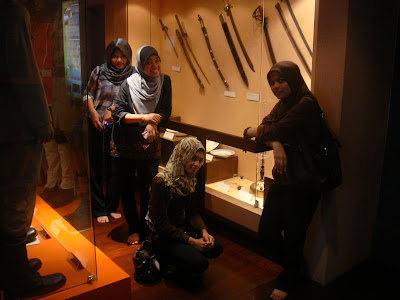| | Bukit Melawati is situated in Kuala Selangor. Bukit Melawati or also known as Bukit Selangor is now a tourist place and is well known in the history of Selangor. During the 19th century, there was a fort built on Bukit Melawati The purpose of this fort was to defend the state of Selangor from its enemies which came from the river mouth. Sultan Ibrahim Shah, the second Sultan of Selangor that reigned from the year 1778 until 1826 instructed that a fort be built at the peak of Bukit Melawati for defence. The purpose of building this fort was an effort by Selangor to avoid attacks from the Dutch. As the Dutch was trying to capture Johor - Riau and Selangor had strong relationship with the government of Johor and Riau, the Sultan of Selangor was afraid that the Dutch would retaliate and attacked Selangor. |
|
| 

|
The fort was built with solid stones arranged closely and almost half of Bukit Melawati was built with stone pillars and decorated with several cannons. In order to avoid erosion of the hill, raintrees were planted. The fort has a big entrance about 3 meters wide facing the east and has a staircase leading to the courtyard. From the courtyard if you go down the staircase which consisted of twenty steps made of solid stones it will lead you to a small hill called Melawati Hill. This entrance has been used by the Sultan and other dignitaries to hold their ceremonies.
| |
| | The second entrance which was about two meters wide was situated on the east side near an existing rest house. The third entrance faced the west and was used as an entrance from the defence fort at Bukit Tanjung Keramat. This entrance was equipped with several cannons measuring about 2 to 5 meters facing the direction of Kuala Selangor. During the 18th century, fighting broke out between the Dutch who were based in Malacca and the people of Selangor who were defending their land. In the year 1758, the Dutch who were ruling Malacca made an agreement with Sultan Salahuddin. In the agreement, the Sultan allowed the Dutch ships to sail into Kuala Selangor for the tin trade. Ships who requested for permission from the Sultan of Johor were also allowed to sail into Kuala Selangor as the Sultan of Johor was on good term with the Dutch.
|



During the Anglo-Dutch war between 1780 and 1784, the status and influence of the Dutch became weak. The Sultan of Johor and the Sultan of Riau conspired to overthrow the Dutch as they wanted to get control of Malacca again. The Sultan of Selangor at that time was Sultan Ibrahim Shah, the second Sultan of Selangor who replaced his father, Sultan Salehuddin.
| |
| | On 13 July 1784, the Dutch army which consisted of 11 ships and several vessels belonging to the Raja Muhammad Ali of Siak arrived at Selangor and a war broke out between the Dutch and Sultan Ibrahim. The war lasted for two weeks and the fort was nearly destroyed. On 2 August 1784, the fort fell into the hand of the Dutch. Sultan Ibrahim, his son Raja Nala, Sayid Jaafar and the other royal families retreated to Hulu Selangor. The Sultan further retreated to Bernam and from Bernam to Pahang. In Pahang the Sultan managed to get assistance from the Bendahara Abdul Majid to recapture Selangor.
| |
| | The Dutch who had captured Kuala Selangor appointed Raja Muhammad Ali from Siak as the regent of Selangor. The Dutch also made a peace agreement with Raja Muhammad Ali thereby further strengthened its stronghold in Kuala Selangor. After the war, Fort Malawati was repaired by the Dutch and equipped with better cannons. The Dutch named the fort at Bukit Malawati "Altingsburg", which was the name of the Dutch Governor General at that time, that is Governor General Alting.




|
|
| | The fort at Bukit Malawati was further strengthened and the area around the fort was lighted up so that enemies can be seen from the land and the sea. However the victory of the Dutch in Kuala Selangor does not mean that the war was over. In fact Sultan Ibrahim who had retreated to Pahang was building up his army. The Sultan�s followers who were left behind at Kuala Selangor made attacks on the Dutch. The followers of Sultan Ibrahim did not recognized the Dutch and Raja Muhammad Ali from Siak as their rulers. The Dutch tried to made peace with the followers of Sultan Ibrahim but failed.


On 27 July 1785, a year after the Raja Muhammad Ali ruled Kuala Selangor, war broke out again in Kuala Selangor. Sultan Ibrahim came with 2,000 followers from Pahang to recapture Kuala Selangor. In Kuala Selangor, Sultan Ibrahim�s army build their defence fort at Permatang which was further strengthened when the people of Permatang joined the army. On the night of 27 July 1785, war broke out when Sultan Ibrahim launched a surprise attack on the Dutch. The Dutch were defeated the following morning and they fled from their forts in Kuala Selangor in their ships. On 28 June 1875, Sultan Ibrahim with the help of Pahang succeeded in capturing Kuala Selangor and Fort Malawati. The Dutch did not have the time to destroy the cannons in the fort.When Sultan Ibrahim passed away, he was buried at Bukit Selangor which is now known as Bukit Malawati whereas the Regent of Selangor was buried at Bukit Tanjung Keramat.
| |
| | Today, Bukit Malawati offers a panoramic view of the Selangor coast and the Klang Valley. Besides Fort Malawati, there are several other facinating historical attractions such as the Altingsburg Lighthouse, the Royal Mausoleum, the fabled execution block, children�s playground, the legendary 100 steps and a quaint rest house. |


|
|
|



















No comments:
Post a Comment